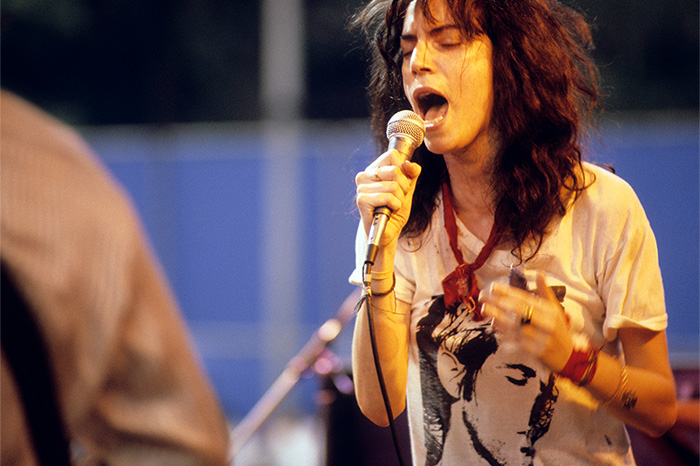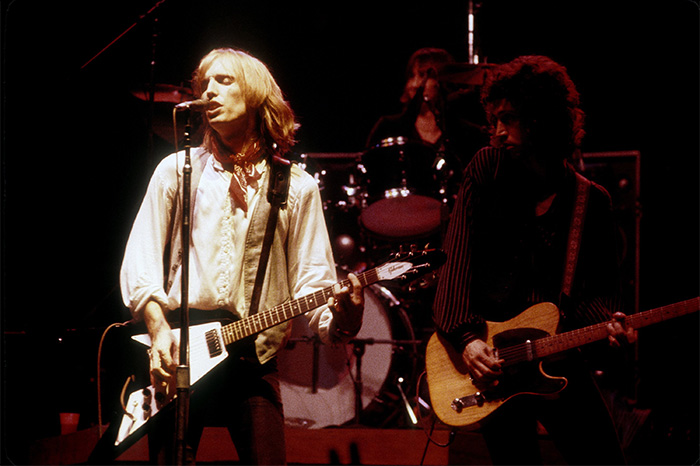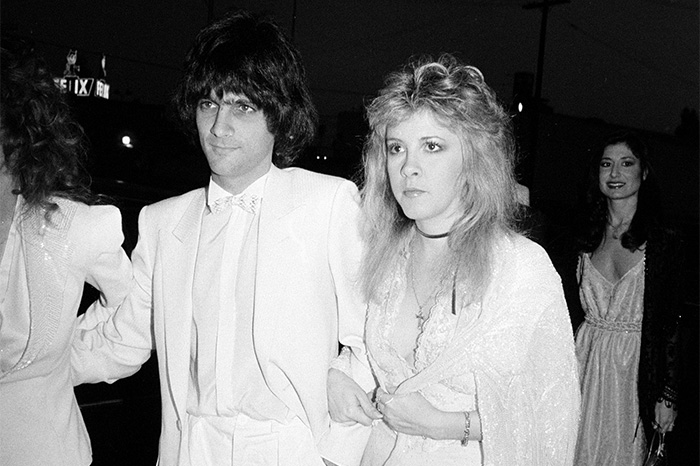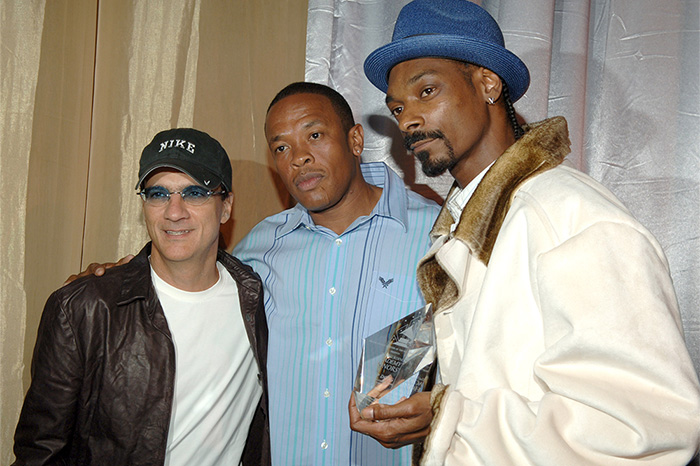Show Rundown: June 26, 2017
Howard Remembers Dr. John Sarno: ‘He Was An Amazing Man’
VIDEO: Watch Gary Dell’Abate’s Dog Riley Frolic With His Deer Friend
Jimmy Iovine Shares Stories of John Lennon, Bruce Springsteen, Dr. Dre, and Why He Hid Stevie Nicks in His Basement
Jimmy Iovine Shares Stories of John Lennon, Bruce Springsteen, Dr. Dre, and Why He Hid Stevie Nicks in His Basement
Music exec also tells Howard what his dream retirement looks like
Throughout his interview on Monday’s Stern Show, record producer and music executive Jimmy Iovine told Howard one reason he’s achieved so much success was his willingness to “be of service” to the many, many stars he’s worked with — acts like John Lennon, Bruce Springsteen, Stevie Nicks, Tom Petty, Dr. Dre, Elton John, and Gwen Stefani (just to name a few).
“I always knew which side of the glass was more important,” Iovine said of his role in the recording studio.
With five decades in the music industry and a bevy of smash hits to point to, Jimmy had quite a few stories to share with Howard during his Stern Show debut. Check out the highlights from his interview (below) and watch Jimmy’s documentary series “The Defiant Ones” premiering on HBO July 9.
Early Days With John Lennon, David Bowie, and Elton John

One of Jimmy’s first jobs as a recording engineer came with one of the biggest names in music — John Lennon. After paying his dues as a studio assistant at New York’s famed Record Plant, Jimmy got the gig with the former Beatle after showing up to the studio to work on Easter Sunday. His bosses were so impressed, they connected him with Lennon.
“I did three albums with John. That’s a lot of time,” Jimmy told Howard, adding that he and Lennon formed a comfort level between them. “We hit it off and that’s kind of why he let me in the studio,” Iovine explained.
Jimmy believes their bond was why John asked him to be in the studio the day he recorded his vocals with David Bowie on the eventual hit “Fame.” John laid down his part rather quickly, but the song and Bowie’s album “Young Americans” have stuck with Jimmy ever since.
“That album set the tone of … a big part of my music career,” Jimmy told Howard. Bowie’s ability to mix soul and rock and roll influenced Iovine and shaped what he believed was possible in music production. Years later, Jimmy hired the very same backup singers Bowie used on his song “Young Americans” for a record he produced with the band Simple Minds.
Another larger-than-life figure Jimmy encountered while working with Lennon was Wall of Sound maestro Phil Spector who Iovine recalled coming to work dressed in a butcher’s coat along with two guns and a boat horn.
“That’s how he’d get my attention,” Jimmy said of Spector’s horn. As for the guns, Iovine remembered a recording session in which Phil made a scene, shooting off his weapons in the bathroom. It got them all kicked out of the studio.
Wild antics didn’t end with gunplay, either. Jimmy told Howard there was plenty of drugs and alcohol around in those days, as well. “I was so young,” he said. “I used to have to go out and buy the Courvoisier. I had to borrow ID to buy it.”
The day Elton John was due in to play on Lennon’s “Whatever Gets You Thru the Night,” Jimmy was given the opportunity of a lifetime after his boss didn’t show up for work. Iovine subbed in as that session’s studio engineer, but when asked to set up the microphones for Elton’s piano he realized he had no idea how to produce Elton’s signature sound on the keys.
“I realized, at that moment, that Elton’s piano sound is in Elton’s hands and the way he bangs it,” Jimmy told Howard. A simple set up worked and even got a compliment from Elton on his way out of the studio.
“And John [Lennon] just said, ‘That’s why we use him,'” Jimmy told Howard.
Bruce Springsteen’s Work Ethic

There was a lot at stake for Bruce Springsteen with his 1975 release “Born to Run” and he was relying on Iovine, his engineer, to deliver on a sweet sound.
“Sony was gonna drop him. It’s not a secret,” Jimmy said of Springsteen’s must-win predicament with what would be his third studio album. However, even with his back up against the wall, Jimmy revealed Bruce never faltered on sticking to his vision and putting out the album he wanted to put out.
“Bruce is not for sale. He’s not even for rent,” Jimmy said. “There is nothing you have that he wants.”
Bruce’s dedication led to long studio sessions spanning six to seven months. “He had a sound in his head and couldn’t get it,” Jimmy told Howard. But Bruce (and everyone working with him) stuck at it.
“I learned my work ethic from this guy. This guy’s got the greatest work ethic, the most discipline, of anyone I’ve ever met in my life,” Jimmy said.
After the master of the record was done, Jimmy told Howard he met Bruce out on the road to play him what they’d all worked so hard on. His mistake was giving Bruce his first listen at a record store on a stereo system with less than ideal speakers. Later on, Jimmy met Bruce back at his motel to see if he liked what he heard — Bruce took the record and threw it in the pool.
“To me, he threw me in the pool,” Jimmy remarked with a laugh, explaining he felt so bad, he might as well have been the one who got wet. He didn’t quit, though.
“I knew there was a prize somewhere,” Iovine said.
“Born to Run” was released and became not only a big hit for Bruce, but it earned Jimmy a reputation as one of the best in the business.
Fired by Foghat, Hired by Patti Smith

The band Foghat took notice of what Jimmy accomplished with Springsteen and asked for his help on their next album. But the gig was short-lived after Jimmy forgot his own rule about putting the artist first.
“I was breathing my own exhaust,” Jimmy told Howard of how he soon enjoyed his new-found success a bit too much. “I brought my girlfriend to the sessions. I let her run the tape machine,” he admitted.
Foghat wasn’t amused and cut Jimmy loose. But he learned his lesson fast and soon got a call to produce Patti Smith’s next album. Jimmy wanted her to hear a song Bruce had been working on that hadn’t yet made one of his own albums. Smith was sent the track, but it took several pushes from Jimmy before she actually listened to it.
“I just knew it was magic,” Jimmy said of the unreleased Springsteen tune. He was right.
After finally listening to the song, Patti got straight to work on writing the lyrics that would complete “Because the Night.” She brought them to Jimmy and by the very next day the two were in the studio recording.
Since the song achieved so much success for both Jimmy and Patti, Howard wondered if Bruce was ever upset about forfeiting “Because the Night.” Quite the opposite: Bruce give him high praise for what he could do with the track. On Monday, Jimmy gave Bruce high praise right back.
“The three of those people —John Lennon, Bruce Springsteen, and Patti Smith — were my college education,” Jimmy told Howard, explaining that producing their albums gave him all the knowledge he needed to succeed in the recording industry.
Shaking With Tom Petty

Next up for Iovine was Tom Petty who wanted to hire Jimmy as an engineer on his album “Damn the Torpedoes.” Jimmy, however, knew he had graduated to producer and worked out a deal with Petty to helm his next offering.
The album included the song “Refugee” which Jimmy described as being “a beast” due in part to a drummer that could not keep the right time on the track. For six weeks, Jimmy pressed the drummer hard on improving his tempo. Finally, Jim Keltner, another drummer also in the studio, suggested Iovine add a shaker to the song.
“That’s what made the record sound the right timing to me. It was never right ’til that,” Jimmy told Howard. To this day, Iovine said he can still prominently hear the shaker in the background of “Refugee.”
Stay in the Basement, Stevie Nicks

According to Iovine, many in the music biz were of the opinion that Stevie Nicks was incapable of singing more than three songs on an album, like she had done with Fleetwood Mac where she split lead vocals with Lindsey Buckingham and Christine McVie.
“Are you out of your fucking mind?” Jimmy said on Monday of how he felt whenever he heard someone say that about Stevie back in the day. He was more than willing to work with her on her debut solo album “Bella Donna,” but what he didn’t realize was how fast their relationship would turn romantic.
“I was terrible with girls,” Jimmy said of his ability with women. “I just had no idea.”
If Jimmy was as bad with the opposite sex as he suggested, Stevie didn’t seem to mind — it wasn’t long before she was living in Jimmy’s house. But Jimmy became concerned that his other rock star client, Tom Petty, would become jealous, not of his and Stevie’s personal relationship, per se, but of their professional one.
Since Jimmy was supposed to be “100 percent” invested in producing Petty’s music, Jimmy would ask Stevie to stay out of sight whenever Tom came over to the house, going so far as to hide her in his basement.
“I said do me a favor … when he comes, just stay down there,” Jimmy recalled for Howard. Watch Iovine tell the full story in the video (above).
Eventually, Jimmy came up with an idea to bring Stevie and Tom together on their eventual rock duet “Stop Dragging My Heart Around.” The single wound up on Stevie’s album, though, and may have hurt Tom’s record sales in the process, causing a rift between Iovine and Petty.
“He just didn’t like how it went down and neither did I,” Jimmy told Howard.
The two have since made up and are now on good terms. Tom was even interviewed for “The Defiant Ones” and, according to Jimmy, joked about making so much from “Stop Dragging My Heart Around” it bought him a house.
Starting a Label With David Geffen’s Help
After a string of successes with Bob Seger, Dire Straits, and U2, Jimmy Iovine realized he was ready for a change in his professional life.
“I felt kind of like an athlete,” he told Howard. Up to that point, producing hit music was easy for him, but eventually Jimmy said he began using his brain rather than his heart. He decided the time had come to start his own music label, Interscope Records, but he knew he’d need his friend David Geffen’s help if the new venture was to be successful.
“Business to him is an art form,” Jimmy said of Geffen’s abilities. “He just shows you how to move.”
Geffen was instrumental in helping Jimmy get Interscope off the ground and to this day Iovine is grateful to have Geffen in his corner. “David Geffen has never gotten anything from me except friendship and he’s given me so much wisdom over the years,” he told Howard.
Forget Sneakers, Let’s Make Speakers

It wasn’t long after starting Interscope that Jimmy Iovine was linked up with another up-and-comer, rapper Dr. Dre. The two inked a deal, along with Dre’s partner Suge Knight, for Interscope to take over distribution for Death Row Records, a record label focusing on hip-hop, R&B, and gangsta rap artists. Howard asked Jimmy if he ever got nervous by the war being waged between West Coast rappers (many of who were signed on Death Row) and their East Coast counterparts.
“In a lot of ways, it was terrifying,” Jimmy admitted. But as was the case in his previous professional challenges, Jimmy allowed fear to propel him forward. “Going backwards is not an option,” he told Howard.
His and Dre’s partnership didn’t end at making and producing records, though. Jimmy told Howard about the fateful day he ran into the rapper-turned-music mogul while walking the beach and heard about a prospective sneaker deal Dre was considering.
“I said, ‘Dre, fuck sneakers, man. Let’s do speakers!'” Jimmy told Howard. That led to the two coming up with Beats, their own line of personal speakers and headphones. After all, who would know more about listening to music than them?
“How could we miss? We make records,” Jimmy told Howard.
The Beats brand became so popular, it caught the eye of Apple who bought the company in 2014 for a reported $3 billion. Jimmy also got a pretty nice payday as well as a new executive role at Apple.
With enough money and a legacy in the music industry to be proud of, Howard questioned if Jimmy was ready to retire. He replied it wasn’t time to hang it up yet, but he does know exactly what his perfect retirement entails: waking up, reading the paper, and then going for a swim — something he couldn’t do until recently.
“I was a person who didn’t know how to breathe in the shower,” Jimmy told Howard. It wasn’t until he took a swimming lesson with the same man who taught Charlie Chaplin to swim that Jimmy felt comfortable in the water. “This guy, in two hours, had me at the bottom of the pool with his foot on my back,” Jimmy said with a laugh.
After his dip in the pool, a retired Iovine would most likely walk on the beach with his wife, Liberty Ross, before lunch and a quick nap.
“Now it’s 4 o’clock, my wife’s English, it’s tea time,” Jimmy told Howard of what he’d do after waking up. He then would watch some cable news before having dinner with friends followed by an early bedtime, with the exception of Friday nights. That’s when he and his wife have their date night out on the town — some good food, some drinks, all capped off by some R. Kelly at home.
Howard concluded his interview with Jimmy by asking if he was happy.
“I’m happy as all fuck,” Iovine replied with a smile.
See Jimmy Iovine in the HBO docuseries “The Defiant Ones” premiering July 9.






